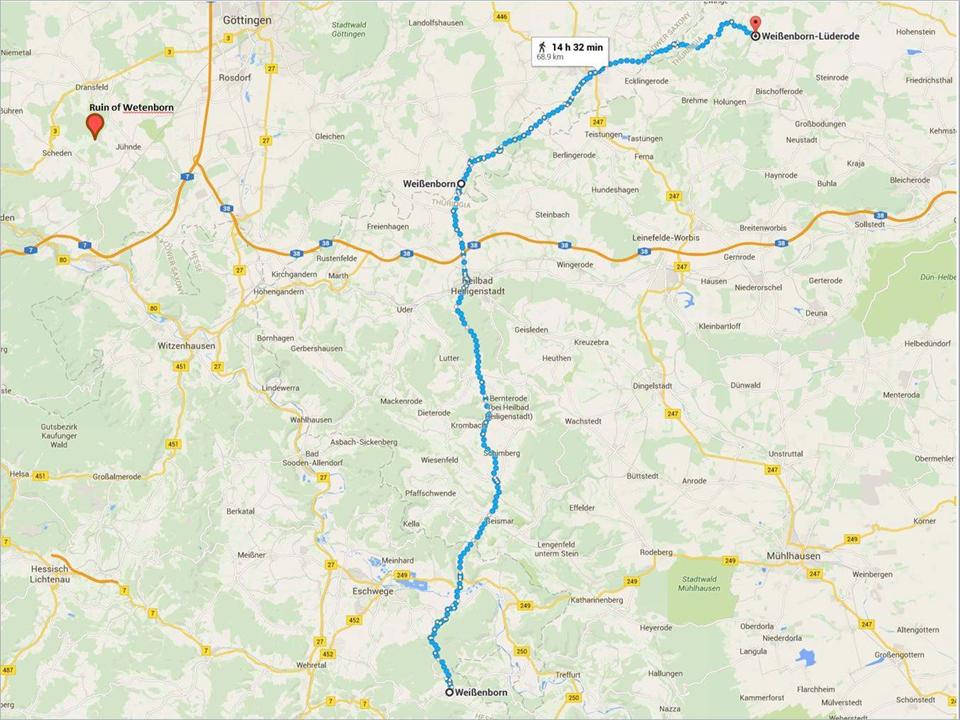The villages Weißenborn near Heiligenstadt and Weißenborn-Lüderode.
Posted on Facebook on 30 November 2015. In one of my earlier posts I have quoted what the 1724 travel guide of Kerstlingerode had to say about the meaning of the name Weissenborn. On the attached map I have indicated the locations of the two villages Weißenborn mentioned in chapter 19 of this travel guide, as well as the village Weißenborn near Eschwege. It is seen that these 3 villages Weißenborn all lie close to the border of Thüringen, the first two just outside it, and the last one just inside it. Chapter 19 of the 1724 travel guide provides the following details about the first two villages Weißenborn in the title. "Weissenborn on the upper right handside of the Garte [the one near Heiligenstadt], where the Garte-stream has its origin, is in the old papers that are kept in archive of Rittmarshausen called Witteborn or Weisseborn, as it has the name of the spring that wells up at the top of the village from a rock near the Kirch-berg and is named Weisseborn, either for the white stone mass from which it appears or for the nice clear water that it produces. Long ago it (the spring) has been walled, its masonry is still in good condition and it has to provide water for most inhabitants, as apart from this (spring) there are no more than 2 or 3 other springs; it produces steadily, runs through the middle of the village and at the foot of the village drives a mill which is 49 foot long and 10 foot wide at its top, and 13 foot at its bottom. There is also a Weissenborn on the Eichsfeldische border, a good hour from Heiligenstadt [= today's Weißenborn-Lüderode]. Before the 30 Years War it was full of beautiful buildings. Most houses were made of stone up to the roof, the farms had ring walls and well kept stone entrance buildings and the streets were paved with pebbles and clay stones. In the war time the inhabitants relied on their fortified farms. Several (inhabitants) gathered on the Kirch-berg that was hard to get on and resisted the oncoming enemy by charging small cannons with hands full of musquet bullets, and firing them. They chased away a group of soldiers of a imperial army under command of count Tylli, killing more than 20 men. After 3 days a stronger group returned that set fire to the village in several places. So that no materials like wood and stone would remain for rebuilding of the houses, the enemy filled the best houses with straw and set it alight. This made the wood turn to ashes and rendered the walls brittle so that they collapsed. In the difficult times later on it proved hard to restore the village, but still most of it has been rebuilt, counting 48 houses. Outside Weissenborn near the Eichsfeldische border stands the church on a high hill which measures more than 200 steps from its foot to the church yard. It is a "filial" church of Bischhaussen dedicated to bischop Nicolas. Anno 1681 on the saturday before Whit Sunday the wall of the church collapsed at midday, just as the priest, after hearing confession, had set foot outside it, to leave. It was rebuilt promptly. Anno 1701 a child was born here who had very short arms, and only three fingers on each hand. It died shortly after birth." As for my own ancestors: a few months ago I found in the 18th century newspapers of Kassel that in Ermschwerd lived a Johann Martin Wittenborn at the same time as my ancestor by the very same name lived in Kassel. Ermschwerd lies close to Witzenhausen, which is shown on the attached map, halfway between Kassel and the village Weißenborn near Heiligenstadt. I have visited this village Weißenborn. It is small, and it left only a faint impression on me. That will change (I will change that), if the two Johann Martin Wittenborns prove to be related.
